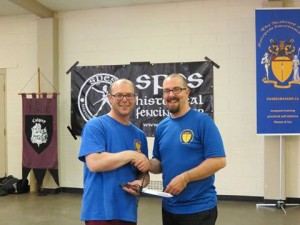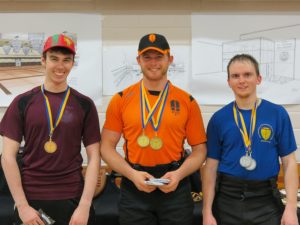As in previous years the most prestigious prize for all participants is the sportsmanship prize. In prior years there has only been one prize for this. Sportsmanship includes all manners of conduct both in the Fechtplatz (fight ring) and outside of it. Any instructor participating will be judged by the behaviour of his/her students, as well. Thus, if an instructor is competing and one of his/her students is penalized for any reason, this may count against the instructor’s scoring for the sportsmanship award.
Nordschlag 2023 tourney currently has these armed divisions:
- Open Steel Longsword,
- Sword & Buckler,
- Women’s Longsword (with enough participation) – this latter event is done in order to encourage overall participation. Women may fight in this as well as the Open divisions, and are encouraged to do so, and
- Random Weapons (single elimination fun tourney).
Each category must have a minimum four people per division.
Participation in multiple categories per participant is explicitly encouraged! There is no extra cost to participate in multiple events, and learning and fun is to be had.
Kicking and punching will not be permitted as part of the conduct, due to recent events in the overall martial arts community and how such combat is now viewed from a legal standpoint in Canada.
Sportsmanship

2015 Sportsmanship Award
(knife donated by SGT Blades Inc.)
- Anyone who loses their temper during a match may be disqualified from the event.
- Anyone who strikes without control and hits too hard will have one warning. The second such strike will be a loss of that round. In previous years this has been an issue with the sword events and we would like to avoid it this year. We are martial artists and should be able to control our blows enough that people are not injured through the protective gear.
- Unsportsmanlike conduct can, at the discretion of the judges, eliminate you from all events. And will most likely cost you the event you are currently competing in, regardless of your current placing.
- Any excessive force or refusal to listen to the referee can result in loss of points (or points awards to the opponent), disqualification from an event, or ejection from the tournament.
- If anyone continues to fight after the halt is called, they will be given one warning. If this happens again, then the referee may, at his own discretion, disqualify that competitor from the match or the event.
Weapons
- Steel longsword must be approved Federscherts or equivalent, and follow Prairies Historical Fencing League (PHFL) rules. No siderings will be permitted. Maximum length is 140 cm (Pavel Moc Federschwert).
- For the Sword & Buckler event, no baskethilted swords of any type will be permitted. This means that Scottish Baskethilts and Schiavone type swords are not permitted. All swords are limited to arming swords or Messers without knucklebows. A single Negel, or similar, will be permitted. Maximum length is 41 inches.
- All steel shortswords/Messers must be approved by the AES. No Einsefer Messers!
- ALL outside weapons are subject to approval and follow PHFL guidelines.
Judging
All bouts are refereed by four judges and one referee. The decision of the head referee is final. Any argument can result in disqualification.
Additionally, competitors may call a hit against themselves. For example, if competitor A feels that competitor B landed a fair hit, competitor A may call a halt and tell the referee. In this instance the competitor’s call overrides all other calls! The referee will decide the number of points awarded in this instance. Please note that this is one of the considerations in the sportsmanship prize, which is the most coveted prize in our competitions. However, competitors cannot falsely call against themselves; if they are believed to be doing so, this will be considered poor sportsmanship and may result in penalty points.
The competitor that wins the most events at his/her division level will have his/her name inscribed on our helm trophy for that year as the all-around champion.
Coaches, Scorekeepers’ Table…
Each competitor (fencer) is allowed only one coach in his or her corner. Only coaches, competitors, and the tournament staff are permitted in the Fechtplatz (fighting ring/square). If competitors and their coaches are not currently fighting, they are not permitted in the Fechtplatz area. Only the tournament staff are to approach the scorekeepers, unless permission is given by the referee on duty or head referee.
Note: in previous years we had photographers interfering with the judges right of way. If a photographer, or any other observer, does this the judge has the right to step on/over the person. Any injuries resulting will be the sole responsibility of the observer. The referee has the right to eject anyone who interferes with the judges or the ring in any manner from the event.
Timing of Rounds
All events will be timed this year. All rounds will be 90 seconds. Women’s longsword will depend on the number of competitors and will be announced prior to the event starting. During pools the clock will not stop unless there is an equipment timeout or an injury timeout.
Challenge
Each competitor may challenge a call of the referee/judges. This means that if the competitor or his/her coach feels that the referee’s call is completely off, then the coach calls “challenge!” At this point the referee will approach the coach and ask the grounds for the challenge. The coach is to succinctly state to the referee, in a calm manner, what s/he thinks happened. This will be discussed by the referee and the judges and/or coaches of the opposing competitor. Once discussed, the referee will make a decision that may or may not override the previous call. If the previous call is NOT overridden, then the competitor no longer has a right to challenge. If it is, then the competitor will continue to have that right. Please note that it is not advisable to use this challenge in order to gain points, as that is harder to judge and more likely not to succeed.
(Yes, it is possible that competitors miss feeling/seeing hits against themselves, but it is also possible that one or more judges do not see the full picture, which is why this rule is here.)
Double Hits, Self Calls
The goal of the good swordsman is to hit without being hit. To encourage this, double hits will count against both competitors. If there are three double hits, then both will be counting as a “loss” for that round and move down in the competition rankings.
Double hits are any hits that are judged to be close enough together that both competitors would be injured if it were a real fight. This means that one competitor could strike the other slightly before being hit, and this play could be called as a double hit, scoring against both competitors .
When a competitor wins s/he moves up on the board, while the competitor who loses will move down in the competition ranks. With this kind of elimination style, the one who wins for each level is most likely to be the competitor who loses no matches, thus avoiding the double-hit loss. As in previous years, competitors are permitted to call a hit against themselves. Thus, if a competitor feels that his opponent scored well, he can say that he was hit. A competitor so calling a good hit may override any call of the judges. Scoring rules are below…
Minimum required protective gear:
Note that all gear must meet the minimum requirements as set out in the PHFL rules.
Steel Events Gear:
- Three-weapon fencing mask with back of head protection or equivalent;
- Heavy Clamshell Mitts or equivalent. Koening Gloves must be inspected, as it has been found that these are inconsistent in their quality;
- Padded Jacket/gambeson;
- Groin Protection is required for men;
- Chest protection is required for women. This may be extra padding or a plastron;
- Rigid throat, elbow, knee and shin protection that comes down to at least the ankles;
- Padded Skirt or pant that protect the thighs.
While not mandatory, the following equipment is recommended:
- Plastron
- Ankle and foot protection
No bare skin is permitted to show! This means no shorts.
Those accustomed to doing so may wear “barefoot” style footwear as a minimum, so long as no skin is showing.
Waivers are available to be signed at the tournament and are also available online. Registration will begin at 09:00. Competition is expected to begin at 10:00.
Ruleset
The rules for all sword divisions are identical. The rules are as follows:
The ring will be staffed by four judges and one referee. Any of them may stop the action in case of a hit or for safety reasons (equipment failure, injury, etc.). In case of a safety issue it will be rectified and the competitors shall reset at their corners if the competitors can continue.
In the event of a hit, the judges shall bow their heads so as to not see the other judges. The referee shall then call for each of the following primary criteria: Contact, Quality, Target, and Control. These criteria function as follows:
- Contact: Maximum one point. Two of the judges must agree that there was a successful strike, thrust or slice with edge, point or pommel to a target. Strikes with the cross-guard are illegal. Contact that is flat, grazing or that would have missed an unarmoured target may be disregarded by a judge. Pommel strikes only score if they contact the mask or are mimed to another part of the head. If there is agreement, the fencer is awarded one point.
- Quality: Maximum one point. Two of the judges must agree that the contact was done with good balance and technique. Quality points should not be awarded for strikes that are done while the fencer was stumbling, in the process of dropping a weapon, etc. If there is agreement, the fencer is awarded one point. If there is no quality point, then neither of the following two criteria will be called. A pommel strike may be awarded this point if the judges believe that it could have been a hard hit, even if the strike was mimed (for safety).
- Target: Maximum three points. If a fencer has received the awards for Contact and Quality with no afterblow, the fencer may be eligible for Target points. Target points are awarded for successfully scoring a point on the head or torso of the opponent. If a judge believes the strike contacted the head or torso, he may award a Target point to the competitor. Thus a total of three Target points may be awarded for such a strike, in addition to those awarded for Contact and Quality.
- Control: Maximum three points. If a fencer has been awarded points for Contact and Quality, he or she may be eligible for Control points. Control points are awarded for successfully controlling the opponent’s weapon while delivering the scoring hit. Examples include a grapple or shove that keeps the opponent’s weapon from being brought to bear, or a scoring while controlling the opponent’s weapon with one’s own (usually a winding/absetzen/attack in opposition). Also, covering/positioning the weapon during or immediately after the scoring point’s tempo such that the opponent’s attempted afterblow is locked out qualifies for Control. Thus, a thrust into Ochs that such that the opponent’s afterblow is directed into the crossguard would qualify, but a strike followed by a hanging parry while retreating would not. If a judge believes there was control, he may award a Control point. Thus, three Control points may be awarded for such a strike, in addition to those awarded for Contact, Quality, and Target.
NOTE: the last two of these are scored separately! A competitor may score points for target or control or for both of these! Thus, if a competitor has control but strikes the leg of his/her opponent, the control point(s) may still be awarded, even if there are no points for Target.
Secondary Scoring Criteria
- Afterblow: An afterblow is a “revenge strike” given in the tempo following a successful hit. Thus, if fencer A scores a hit, Fencer B may attempt an afterblow in the next tempo. If the strike has been judged as a hit, then the opposing fencer (the one who had the original strike) will score one point only for that pass. If there is too much of a delay in the afterblow, it may be viewed as poor sportsmanship, since this must fall within the natural tempo of the fencing bout. Such may warrant a warning, or if it is too hard of a blow, deduction of points or loss of the bout. Also, note that a bout may not be won on an afterblow. NOTE: no afterblow is awarded if the initial strike is to the weapon hand/arm. In Longsword this will be deemed to be the dominant hand only. Thus, it is still possible to score two points with such a hit (one for contact, one for quality).
- Takedown: takedowns, including any trips or throws, are not permitted in this tournament.
- Ring Out: Two points. If a fencer pushes an opponent out of the ring while maintaining control of the engagement (generally by body contact or weapon leverage, i.e. Hende Drucken) he will be awarded two points. A mere shove that happens to shove a fencer out of the ring will not suffice. A bout may not be won via Ring Out. A ring out may not function as an afterblow.
- Striking the floor: If a fencer has such poor control that s/he strikes the floor, then the referee will give a warning. These may, at the referee’s discretion, be counted as uncontrolled, brutality strikes and fall within this criteria (below). Alternately, after an initial warning, the referee may award a point to the opponent.
Penalties
- Brutality: If the referee feels that a competitor is showing disregard for the safety of his opponents, he may be summarily ejected from the tournament. For the first infraction, the referee shall usually issue a warning. Two warnings shall result in ejection from the event, possibly the tournament (referee’s discretion). The referee may eject on the first warning if the infraction was especially and deliberately egregious (i.e. attacking an opponent after his mask falls off, etc).
- Non-combativeness: If a fencer continually disengages and retreats, he will be given a warning. Subsequent infractions result in being penalized one point. Continual non-combativeness will result in the offending fencer forfeiting the match.
- Illegal techniques: The following techniques are illegal for this tournament and will result in a warning, a point deduction, match disqualification, and ejection from the tournament (in that order) for successive violations:
- Crossguard strikes,
- sword throwing,
- throws deemed to be dangerous,
- half-sword thrusts with the point (these may be mimed, but contact is not permitted),
- mordschlage,
- joint destruction or locks that are deemed to be dangerous,
- small joint manipulation,
- purposeful strikes to the back of the head or neck [accidental strikes have happened and are not penalised, although they may not be awarded points, per referee’s discretion],
- chokes,
- strikes with the knees, elbows, hands or feet; and
- uncontrolled striking a downed opponent with a weapon. [It is acceptable to gently touch, or mime, a downed opponent to demonstrate to the judges that this may have been done.]
Three match disqualifications for illegal techniques will also result in ejection from the tournament.
- Double Hits: If two competitors score hits on each other in the same tempo (the tempo of a heartbeat), it is termed a double hit. No points are scored and the fencers will reset. If a bout produces three double hits, it is recorded as a loss for both competitors . Note that a competitor’s total double hits are deducted from his score for Tournament Champion.
- Unsportsmanlike Behaviour: a competitor is expected to behave with decorum while in competition and on premises. Disputing judges, berating staff and volunteers, losing one’s temper (shouting at an opponent, throwing gear, etc.) will result in warnings, loss of a bout, or ejection from the tournament. This is up to the discretion of the referee(s). Three such warnings will result in ejection, without exception, even if the warnings are across different bouts. It is allowed for a fencer to be upset, but it is not acceptable to spread one’s displeasure to fellow competitors, staff and spectators. Getting upset with one’s self is only normal in a competition environment, but expressing that in a negative manner or towards others is unacceptable. While on premises, all competitors are ambassadors of the Art and of their respective Schools. Competitors are reminded that this is merely a tournament; it is only a game played by comrades-in-arms.
Buckler and Shield Use (may also be applicable in mixed weapons)
Note that the buckler may be used for strikes only if the boss is used for striking with control! Any edge strikes with the buckler will be considered illegal techniques and treated accordingly.
Shields may be placed against the opponent to count as a shield strike. There are to be NO strikes with force. It is up to judges and/or the referee discretion to decide whether a shield placement could have been a strike or is merely incidental. Any shield strikes can score as another weapon (sword) could, so long as the correct form and control is shown. Any hard shield strikes may be cause for a warning or loss of bought (excessive force).


Pingback: Nordschlag 2017 Updates – The Academy of European Swordsmanship